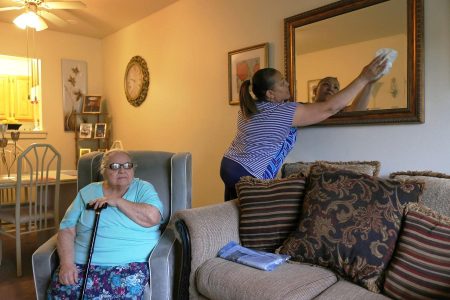After retirement, people have self-reported that they miss the people more than the position or money. Not only are they more limited in social interaction, but as we get older our circle of friends naturally shrinks because of deaths, moves, or lack of effort. In this Forbes article, I describe the loneliness epidemic and the important benefits of making friends as grown-ups after retirement.
Dr. Ruth Westheimer is one of my role models. I was fortunate to hear her speak twice and actually got to personally meet her backstage. Dr. Ruth was writing until the end of her life in July 2024 which kept her engaged, relevant, and curious. Her last book, “The Joy of Connections: 100 Ways to Beat Loneliness and Live a Happier and More Meaningful Life,” focused on loneliness. It reveals how Dr. Ruth – most known for her work in sex education – lived through extraordinary challenges and still forged community and connection during her life.
An orphan of the Holocaust, Dr. Ruth lost her whole family at the age of 10. For this reason, Dr. Ruth worked at creating connections and “finding a new family.” A year before Dr. Ruth Westheimer died, she suggested to Governor Kathy Hochul of New York that she could serve as the state’s first “loneliness ambassador,” and the Governor accepted her offer. Dr. Ruth personally experienced the isolating impact of lockdowns during the coronavirus pandemic.
In “The Joy of Connections,” Dr. Ruth points out the overlap in her work focusing on sexuality and addressing loneliness: “Nobody is excited to admit they’re having difficulty in the bedroom. Nobody is thrilled to confess they have too few reliable friends. Shame is the thread that connects them both, and shame is what I’ve always tried to help people overcome.”
In this book, Dr. Ruth created a framework called her menu for connection—designed as pieces of a pie. It consists of family, friends and lovers, community, technology. The largest pie piece is self. She points out that we need to know ourself—our thoughts, feelings, and actions—in order to have healthy connections with others.
In the “Joy of Connections,” Dr. Ruth shares 100 ways to address loneliness. Catherine Pearson, in a recent New York Times article, outlined five of the more interesting ways Dr. Ruth advocates to feel more connected that can be easily implemented.
Be A Turtle
Dr. Ruth described how her apartment was filled with hundreds of miniature turtles — most gifts from family or friends. Turtles weren’t just her favorite animal; they were a favorite metaphor to remind her of the courage it takes to make connections. To live a full and connected life, you’ve got to stick your neck out. “A turtle can’t hunt for food, bask in the sun, or find a mate if it plays it safe forever,” she wrote. “Turtles must take risks in order to live.”
Lose Count
Friendships undeniably take work to nurture and maintain, and it’s not uncommon in a group of friends or relatives for some people to take (or perceive themselves to take) more initiative and do more logistical, financial, and/or emotional work than others. It’s human to start keeping an invisible score (“it’s always me reaching out,” “I’m always the one who has to…” “they never…”), but it can be a source of tension and even lead to estrangement among friends and relatives.
Dr. Ruth argues that the best way to maintain connections is to practice losing count. For instance, when Dr. Ruth was a single mother with no money for a babysitter, she still had a strong desire to keep in touch with friends, so she started hosting parties. Notably, she hosted and organized these parties without expectations. Even though she was the one who usually initiated plans, she was not resentful and did not keep score. For her, hosting made her feel less isolated, and she didn’t care if people reciprocated.
“Your payback isn’t a future dinner at your relative’s house,” she explains. “Your payback is having the opportunity to strengthen your connections right now on your own timetable.”
Broaden Your “Friendcabulary”
Dr. Ruth believed it was important to pursue all kinds of connections. Work friends. Friends of friends. Casual friends. Research shows weak ties can help boost well-being. She was adamant about not discounting anyone because of gender, age or sexual orientation. Her advice was also to surround yourself with “people who are fully invested in living. Avoid people who whine all the time. They won’t lift you up, and they certainly won’t expand your world in the way you’re hoping for.”
Make Your Town Smaller
According to Dr. Ruth, “Your first order of business is to develop a smaller community within whatever larger communities are easiest for you to access.” She found living in New York City to be a lonely place, so she intentionally set out to make her city smaller. She joined organizations and neighborhood groups. She attended countless meetings and social gatherings. As a result, she felt connected and that she belonged. She knew she would be missed if she stopped showing up.
Invest In Building Connections
We live in a busy world of daily life demands and to-do lists. Yet, we are drowning in information while yearning for connection, belonging, and being in relationships. When we invest the time and effort into being a more generous friend, we will reap dividends. Get out of your comfort zone. Connection is protection. Find the joy in connections.
As Dr. Ruth emphasizes, “If your goal is to feel a sense of belonging, then you must take steps to belong.” Some of her tips include: make yourself more friendly, cast a wider net, and grow independently.
I met an Uber driver who has a regular older passenger—who doesn’t actually need to go anywhere! But after her husband (and best friend) passed away, she started taking a 20–30-minute rideshare once a week. By doing so, it gives her a chance to talk to different people in a low-stakes, contained environment. The driver said that it’s resulted in her connecting with people of all ages and backgrounds, and she often ends up exchanging numbers and arranging coffee with people by the end of the ride. This technique won’t work for everyone, of course, but it’s a great example of thinking outside the box and putting yourself out there for connections to happen naturally.
While we often find it easier to relate to people our own age, we can learn a lot from people younger than us. One last piece of Dr. Ruth’s advice resonated strongly with me, “Be on the lookout for cross-generational opportunities. They invite the sharing of experiences, wisdom, and perspectives.” Take the initiative. Be creative. Stay curious. Start now.
Read the full article here













